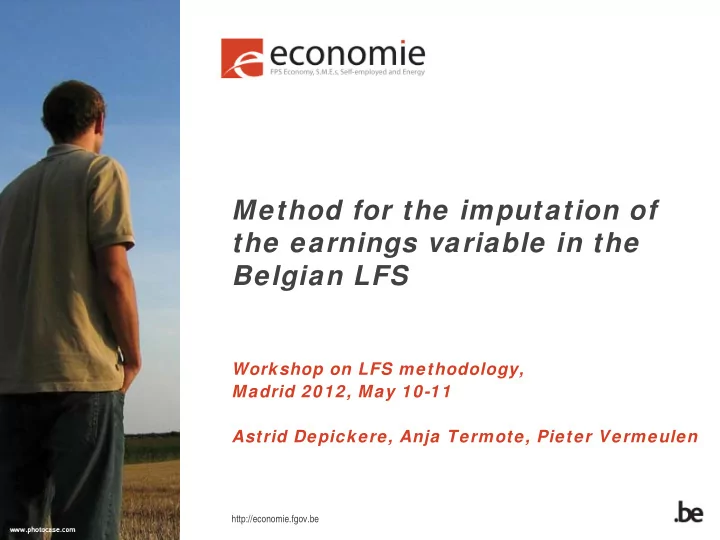

Method for the imputation of the earnings variable in the Belgian LFS Workshop on LFS methodology, Madrid 2012, May 10-11 Astrid Depickere, Anja Termote, Pieter Vermeulen http://economie.fgov.be
Outline 1. Introduction 2. Imputation 3. Imputation method for Earnings variable in LFS 4. Implementation: different steps 5. General evaluation http://economie.fgov.be
Introduction � The Earnings Variable in the Labour Force Survey (LFS) : very high number of missing values. (24,9% in 2011) Number of Missings on Earnings variable LFS 60 50 40 % 30 20 10 0 1999 2000 2001 2002 2003 2004 2005 2006 2007 2008 2009 2010 2011 � In 2009: – Some actions were undertaken to reduce the number of missings – Start imputation of the earnings variable http://economie.fgov.be
Imputation � Imputation = replacing missing values with ‘ credible ’ data from a donor . – What is ‘ credible ’ data? Using what we know in order to say something about we do not know – Donor ? • Same source: borrowing information from the nonmissing observations to impute for the missing observations • External source: using information from another source to impute for the missings � Imputation techniques : Single imputation: generate a single replacement value for each missing – data point. Multiple Imputation: creates several copies of the data set and imputes – each copy with different plausible estimates of the missing values. http://economie.fgov.be
Imputation method for Earnings variable in LFS (1) � Regression imputation using an external source: the Structure of Earnings Survey (SES): – Regression imputation (or conditional mean imputation) replaces missing values with predicted scores from a regression equation. – We use the information about the effects of different personal and job characteristics on the wage level from the SES, – in order to predict a wage level for the missing observations in the LFS. � Why SES (instead of LFS)? – A better measurement of wage variables in SES then in LFS. Earnings are the core variables in SES, whereas they are not in LFS. – High number of missings in LFS: insufficient representativity of the regression model http://economie.fgov.be
Imputation method for Earnings variable in LFS (2) � Some particular issues that needed to be resolved: – Two year gap between delivery of SES data and LFS data ⇒ Indexation on the basis of the Labour Cost Index – SES is a yearly survey but does not always cover the entire market. Some sectors are included only once every four years (ESTAT year). ⇒ Coefficiënts for the missing years are derived on the basis of the last nonmissing year – SES only measures gross wages, whereas for LFS nett wages are needed. ⇒ Applying a gross/nett calculation (taking into account as much as possible the information in LFS on individual an his household) http://economie.fgov.be
Implementation: different steps (1) Step 1: Obtain regression equation from SES – SAS proc GLM – Different models were compared – Final model has a R-squared of 75% – Only main effects, no interactions – Regression parameters were converted into a formula for the prediction of a Gross Monthly Wage logGMW = sex age age2 isco_3d pct_pt nace_2d isced_6cl region size Dependent variable = Independent variables = predictors variable to be predicted http://economie.fgov.be
Implementation: different steps (2) Step 2: Impute Wage variable in LFS – Regression equation is applied – Result = Gross Monthly Wage value for the missing observations in the LFS survey – Apply indexation (by NACE_1d) obtained from the Labour Cost Index Step 3: Prepare LFS dataset for Gross/Nett calculation – Update calculation according to legislative rules: Nett wage is a function of the Gross wage, number of persons in charge, partnership & employment position (and wage) of the partner – Derive household variables http://economie.fgov.be
Implementation: different steps (3) Step 4: determine Nett Wage – By applying the gross/nett calculation, a Nett Monthly Wage value is obtained (for all observations) – Validation of the result: compare imputed values to observed values (for the nonmissing observations) – The method not only serves as an imputation method, but can also be used for data editing (e.g. evaluation of outliers) http://economie.fgov.be
General evaluation � Effect of imputation on estimates (descriptive values): bias remains very small => strong coherence between the sources � Imputed (but biased) data better quality than original ones? http://economie.fgov.be
General evaluation (2) � Effect of imputation on variance and sampling error : artificial reduction of variance, true variance is underestimated � Solution could lie in the use of a different technique: – Stochastic regression imputation – Multiple imputation http://economie.fgov.be
Recommend
More recommend